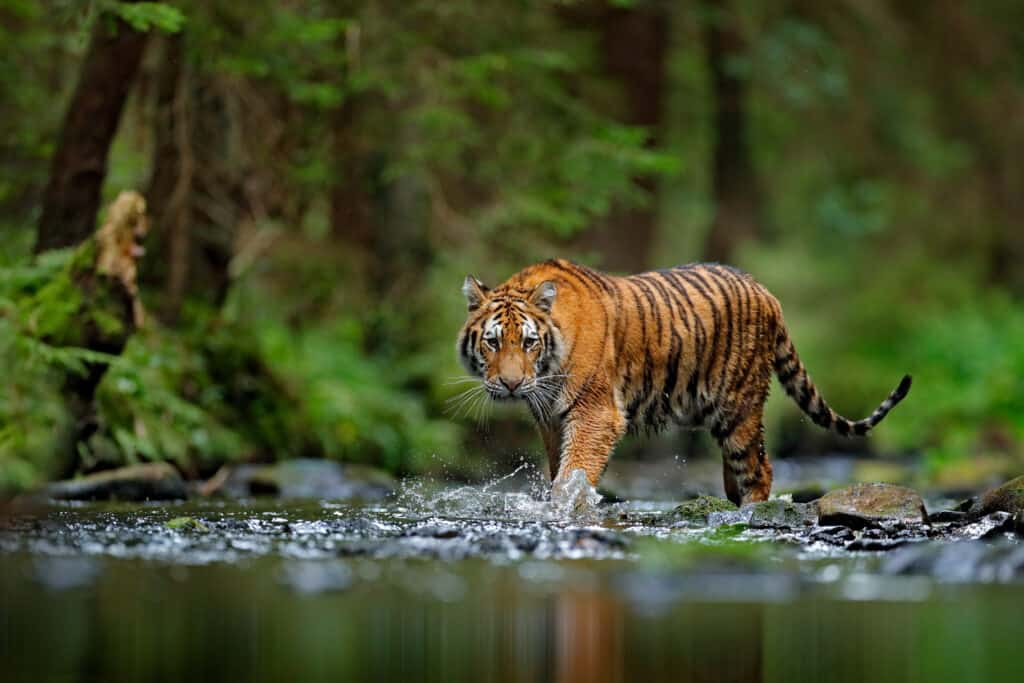As you might have guessed from their name, Caspian tigers once lived near the Caspian Sea in Central Asia. Tigers, once widespread across most of Asia, have lost more than 95% of their historical range in the past few centuries. Today, scientists acknowledge only two species of tiger; the continental tiger and the Sunda island tiger. These tigers were a subspecies of continental tigers; their closest relative is the endangered Amur tiger.
Here, we’ll find out just what caused the demise of the incredible Caspian tiger. We’ll also learn a little more about this apex predator, including where they lived and what they ate. We’ll find out whether or not the scientific community believes that Caspian tigers still exist and, whether they can be resurrected if they’re truly extinct. Finally, we’ll go over some things you can do to help conserve tigers today.
Read on to learn more about the factors behind the extinction of one of the world’s most extraordinary animals.
The Lowdown on Caspian Tigers

Caspian tigers were obligate carnivores.
©public domain – License
Caspian tigers were officially declared extinct in 2003, though most had disappeared by the 1950s. Similar to Amur (Siberian) tigers, these tigers lived in riverine habitats throughout central Asia. Reported to have been some of the largest tigers in the world, Caspian tigers met their fate at the hands of humans. Let’s get to know these big cats better and learn what caused their disappearance.
Habitat and Range
Caspian tigers were native to Central Asia. Their range was huge, stretching all the way from western China to eastern Turkey. But, these relatives of lions, leopards, and cheetahs didn’t occupy every square mile of territory in that range. Instead, these tigers lived in many disconnected territories in Central Asia. This broad, yet very specific range, is due to their unique habitat preferences.
Caspian tigers favored habitats on the banks of rivers. Because of the constant flow of water, riverine environs tend to offer a greater diversity of both plants and animals. For these tigers, that meant plenty of prey, like deer and wild boar. Unfortunately, these tigers were adapted to live in the same places most desired by humans.
Size and Appearance
As with most big cats, Caspian tigers were sexually dimorphic, meaning males were larger than females. Males are believed to have weighed between 350-550 pounds. Because these tigers often lived in areas with cold winters, they had distinct winter and summer ‘looks.’ In the wintertime, their fur grew long and is reported to have been paler, with less distinct markings. Like other tiger subspecies, these tigers were orange, with black and brown stripes along their bodies and tails.
Diet and Behavior
Little is known about the seasonal behavior of the Caspian tiger. However, scientists believe know that, like all big cats, they were obligate carnivores, and would have spent a significant amount of time hunting. Game species would have included roe deer, wild boar, camels, mountain sheep, and other ungulates. Unfortunately, the Caspian tiger’s position at the top of the food chain in its homeland led to direct competition with humans for both food and territory.
What Caused the Caspian Tiger’s Extinction?
The story of the Caspian tiger’s extinction begins with the increasing human population in Central Asia. These tigers lived in the reed beds of riverine valleys, hunting the plentiful game found there. But, as more and more people moved in, more and more of the reed beds disappeared under the farmer’s plow. This led to habitat loss for the exotic Caspian tiger.
Additionally, humans hunted the same ungulates that the tigers hunted. This led both to reduced prey availability, and increased human-tiger conflict. During the 19th and 20th centuries, and indeed right up until their extinction, hunters led campaigns of extermination against the doomed Caspian tiger.
The Last Caspian Tiger
Caspian tigers underwent a gradual, regional extinction beginning in the 1880s. By 1950, the tigers had few strongholds left in only the remotest parts of their former range. The last confirmed Caspian tiger sightings occurred near the Aral Sea in the 1970s.
Could the Caspian Tiger Still Exist?
Caspian tigers were declared extinct in 2003. However, genetic research shows that these tigers and Siberian tigers are extremely similar and likely diverged within the past several hundred years. So, technically, Caspian tigers represent only a part of the subspecies of continental tigers which includes both the Caspian and Siberian tigers. However, due to human utilization of traditional big cat habitats, and the scarcity of prey, there is very little chance that any true Caspian tigers survived to modern times.
Can the Caspian Tiger Come Back?
Caspian tigers are gone for good, but, Amur (Siberian) tigers, their genetic siblings, are currently listed as the same species: the continental tiger. Some scientists believe that small populations of Amur tigers from eastern Russia could be transplanted into the historical range of the Caspian tiger in Central Asia.
The proposed tiger territory lies in Kazakhstan. To succeed in reintroducing tigers to the area, scientists would have to lobby for protected tiger habitats filled with plenty of hooved animals for the tigers to hunt. As of 2022, such dreams are still only a distant possibility.
Saving Our Remaining Tigers

Poaching and habitat loss pose a major risk to the survival of tigers.
©iStock.com/Ondrej Prosicky
Worldwide, tigers face threats from habitat loss and fragmentation, human-wildlife conflict, poaching, and climate change. Tigers occupy less than 5% of their former range, and there are fewer than ten thousand tigers left in the wild. One of the greatest threats to tigers comes from the illegal wildlife trade.
This trade includes both live tigers, and tiger parts, like skins, teeth, and bones. Unfortunately, the demand for illegal exotic animal parts is still alive and strong in many parts of the world. Additionally, conservationists must battle not only for tigers but for the vast territories they require to thrive, as well as the conservation of game animals. But, tigers are both apex predators and keystone species, which means their presence in local ecology is crucial for environmental health.
Up Next
How Many Tigers are Left in the World?
The photo featured at the top of this post is © public domain – License / Original
Sources
- World Wildlife Fund, Available here: https://www.worldwildlife.org/species/tiger
- Endangered List, Available here: https://endangeredlist.org/animal/caspian-tiger/
- Science, Available here: https://www.science.org/content/article/extinct-tiger-lives-close-relative
Thank you for reading! Have some feedback for us? Contact the AZ Animals editorial team.






